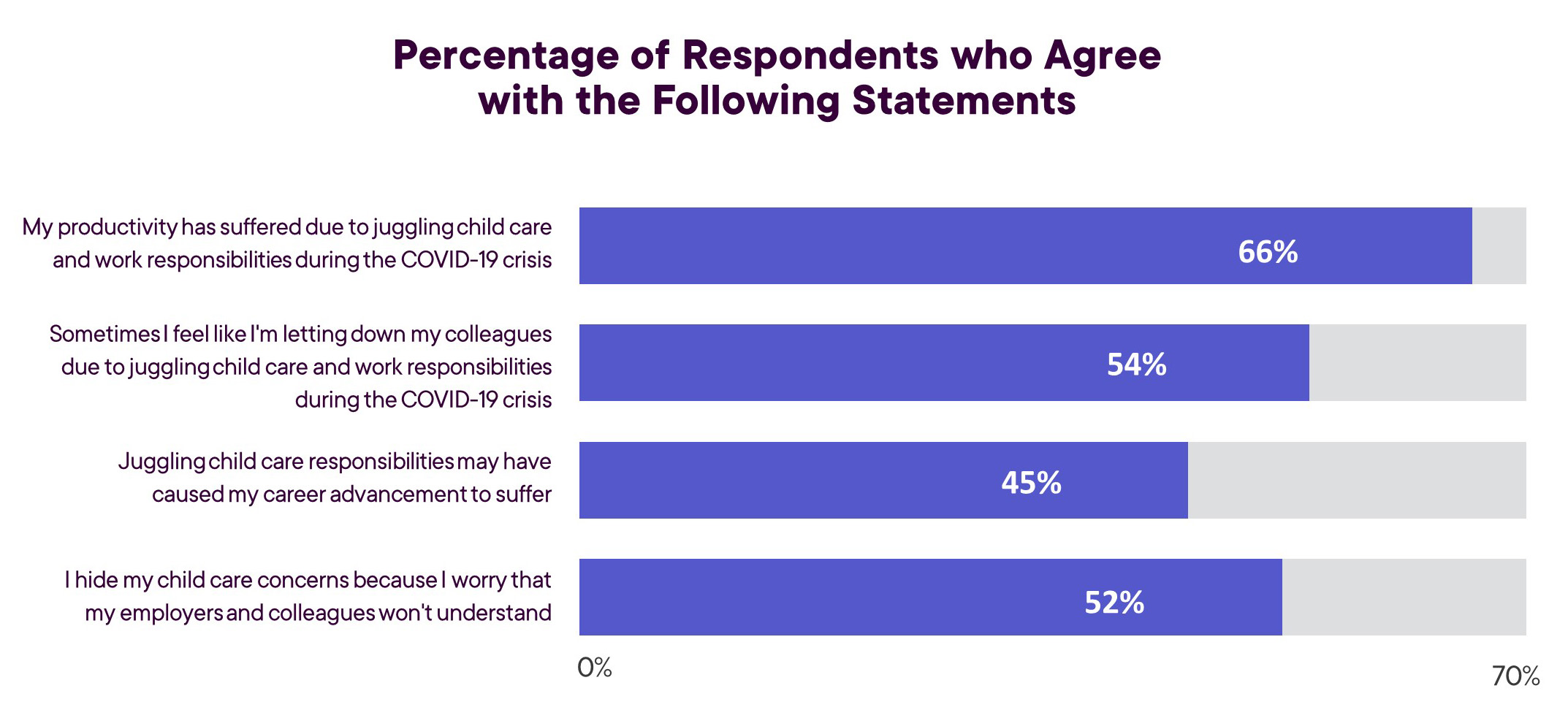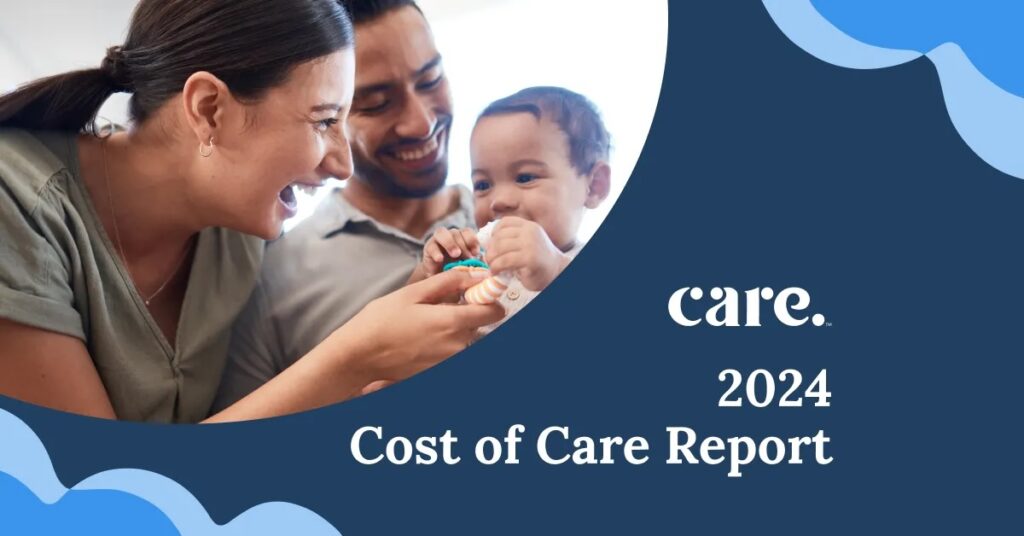This back-to-school season is anything but normal. With distance learning, split schedules, and child care center closures, parents are scrambling to find care so that they can work. A recent survey by Care.com, the COVID-19 Working Parents Survey, asked 1,000 working parents with children under the age of 15 how they are feeling about juggling their child care responsibilities with work responsibilities during this crisis.
This study revealed that 64% of respondents are at least somewhat uncomfortable returning their children to day care or school, and 35% are very uncomfortable doing so. But what should be of even greater concern to employers is that if schools and day cares do not fully open (and stay open), 73% say that they may have to make major changes at work, such as:
- Amending their schedules (44%)
- Looking for a different job (21%), or
- Leaving the workforce entirely (15%)
How employers pivot – how they adapt their culture, policies, and benefits to meet the new demands of this extraordinary time – will have a huge impact on employee engagement, retention, productivity, and overall well-being.
COVID-19 is placing new demands on all parents, but it’s largely women who are picking up the slack
Even before the COVID-19 outbreak, women were doing the majority of unpaid domestic work. The most recent American Time Use Survey (ATUS) by the Bureau of Labor Statistics showed that full-time working women do the bulk of household chores, from housework to cooking to child care.
The pandemic has exacerbated this trend. According to a recent survey of 3,055 working parents by Boston Consulting Group (BCG), parents have nearly doubled the time they spend on child care and housekeeping tasks – on average an additional 27 hours per week – with women carrying the greater share of those increased hours.
That finding was echoed in the recent Care.com study, in which 57% of women say that they take on most or all of the extra child care responsibilities during the crisis (compared to just 8% of women whose partners do more). And male respondents largely agree: just 36% of them say that they do the extra child care work.
As we reported in the 2020 Work + Life Report (which analyzes research conducted just before the COVID-19 outbreak), caregiving responsibilities take a toll on careers in the best of times. And the impact of this unpaid job is even more pronounced now, with over half of the respondents indicating that they hide child care concerns because they worry that their employer or colleagues won’t understand (and this increases to 62% for respondents aged 18-34).
This concern for the impact of caregiving is more than a matter of perception. According to a new study in Gender, Work, and Organization, among heterosexual couples where both parents work and have at least one child under 13, mothers have reduced their work hours four to five times more than fathers, exacerbating a gap in work hours by 20-50%.
Unfortunately, unless and until societal and workplace cultures change, the disparity in caregiving labor is likely to continue. 45% of respondents indicated that “juggling child care responsibilities may have caused my career advancement to suffer,” and notably, 47% of male respondents agreed with this statement, versus 43% of women. And even if our male respondents perceive child care as an equally shared role, it is clear that they don’t feel their employers agree.
There’s a major perception gap in how employers and employees view the success of remote work
One of the few bright spots to emerge from this recent research is that 43% of respondents feel that their employers are more tolerant of them managing their children while working than they were at the beginning of the COVID-19 crisis.
But a big perception gap remains in how employers and their employees view the progress that’s being made. From April 22-28, 2020, during the peak of the stay-at-home orders in the United States, UpWork surveyed 500 hiring managers. They found that 56% of their respondents felt that the shift to remote work had gone better than expected while only one in 10 felt it had gone worse than expected. And “one-third of respondents found that productivity had increased as a result of remote work, a greater share than found productivity decreased.”
On the flip side, the employees we surveyed reached the opposite conclusion on productivity. Whether working full- or part-time (with 71% of the respondents indicating that they are full-time workers), whether working on-site or from home (evenly distributed among respondents), 66% said that juggling work and child care responsibilities during the pandemic has caused their productivity to suffer.
A full return to work will require more child care support from employers – and employees are willing to trade other benefits to get them
Only 15% of respondents currently receive employer-sponsored child care benefits (and notably, in the Care.com study, male respondents are twice as likely to receive them). But among those who do, 85% value them even more as a result of the COVID-19 crisis, with 59% valuing them much more now.
Eighty-four percent of Care.com’s respondents who don’t currently receive child care benefits say that receiving new employer-provided child care benefits is important in order to continue working and raising children at the same time, with 41% overall (and 51% of those living in the Southwest) saying that it is very or critically important. Indeed, 32% rank employer-subsidized child care first, second, or third out of ten possible workplace benefits.
And as in prior research, we found that employees are willing to trade other benefits in order to obtain some sort of subsidized child care. Indeed, 69% of those who don’t currently receive employer-subsidized child care benefits would consider trading one or more of their current benefits to get it, at least while the pandemic persists.
The implication is clear: to retain employees, particularly working moms, employers must provide more and better child care related benefits, even if that means cutting other benefits to do so.
Employers must be proactive in driving change
Of those who don’t currently receive any employer-sponsored child care assistance, 47% believe that their current employer’s commitment to caregiver benefits is lower than it should be, and of that group, 18% say it is much lower than it should be.
But despite their existing concerns about the impact that caregiving responsibilities may have on their careers, few employees — male or female — feel comfortable asking for this kind of support. Only 18% have, and of those respondents, 42% said that their employer was hesitant, with only 14% saying that their employer was very receptive. And of the 82% of respondents who have not asked their employer about the possibility of receiving subsidized child care, 28% overall (and 38% of 18-34 year-olds) don’t feel comfortable asking, and 25% don’t believe the conversation would have a positive outcome.
If they want to retain seasoned talent, demonstrate empathy, and boost faltering productivity, it is incumbent on employers to prove these wary workers wrong.
Our data suggest that organizations that move proactively to address this issue will ultimately benefit.
A full 67% of respondents who don’t currently receive employer-subsidized child care say that they’d be more loyal to their current job if they did (and this increases to 74% for those with children under 4). What’s more, 60% of them say that their job performance would improve if they had this benefit.
Once again, COVID-19 has amplified a trend that we observed in the Work + Life 2020 research, which is that caregiving-related benefits play a crucial role in influencing both employee performance, retention, and acquisition.
Employees are working nonstop to fulfill their responsibilities to both their employers and their families. Now that the boundaries between work and home have dissolved, it’s essential that employers step up and demonstrate the same level of commitment to their workers that their employees have shown them.








